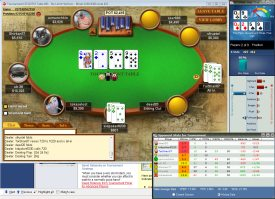This website uses cookies so that we can provide you with the best user experience possible. Cookie information is stored in your browser and performs functions such as recognising you when you return to our website and helping our team to understand which sections of the website you find most interesting and useful.
MTT Strategy – Knowing the M-Ratio
The M-Ratio in Tournaments
One of the most important theories in the world of MTT strategy is the M-Ratio or M-Zone (named after the poker player who invented it – Paul Magriel). The M-ratio is an ever-present forumla used in tournaments to help make shoving/folding decisions and determiningyour starting hands. The following article provides a basic understanding of the M-ratio and how to successfully apply it to MTT strategy.
How to Calculate the M-Ratio
The M-ratio describes the ratio between your chipstack and the total number of the blinds and antes at the tables. Because this makes up the total pot at the table prior to any cards being dealt, the M-ratio tells you how many hands or “orbits” you can survive in an MTT without playing a hand. The higher the M-ratio, the longer you can go without playing a hand and being forced to make a move. The M-ratio is also important because it provides basic strategies for moving all-in and what strength of hands you should do so in. For example, with a low M-ratio, you can hardly expect to wait for a monster hand before shoving all-in. The total blinds relative to your chipstack simply won’t afford you the time to pick up a strong hand.
Mathematics of the M-Ratio
The mathematics of the M-ratio MTT strategy is very simple. To calculate it, just you’re your total stack and divide it by the total size of the pot before any hand is dealt (BB+SB+Antes). For example, if you’re at a 9 man MTT with blinds 500/1000 and with a 100 ante, and you have 10,000 chips, the M-ratio would be:
M = 10,000/(500+1000+900) = 4.2
With an M-ratio of 4.2, you could fold every hand for 4.2 orbits (roughly 37 hands) before you’d run out of chips.
Tournament indicator is a multi-purpose tournament calculator which makes auto M-Zone calcualations for all the opponents at your table for you. Tournament indicator is a great tool especially for new tournament players and is well worth looking into if you’d like to improve your game or ROI.
Applying the M-Ratio to Your MTT Strateg
Dan Harrington broke down the M-ratio to provide an MTT strategy for playing optimally in tournaments. The following provides a very loose guide based on Harrington’s M-ratio.
- If M-ratio is greater than 20 – you can play anyway you choose
- If M-ratio is between 10 and 20 – you have to play risky hands occationslly such as small pairs and suited connectors
- If M-ratio is between 6 and 10 – you should try to be the first player in whenever you decide to play a hand. You’ll also require a bit of luck
- If M-ratio is between 1 and 6 – you have to move all-in
- If M-ratio is between 0 and 1 – you’re relying on pure luck to survive!
Problems Using the M-Ratio
The problem with the M-ratio is that too many players apply it too rigidly in their MTT strategy. All the M-ratio realistically provides is a guide to how strong your position is at the table and type of hands you should be playing. For instance, if you know your M-ratio is below 10, you know you’ll have to start playing some hands and start risking your chipstack soon. If your M-ratio is above 20 on the other hand, you know you’ll have plenty of time to wait for a specific hand i.e. you’re not in any real danger.
Always Take the M-Ratio of your opponents into account: The biggest problem with using the M-ratio in MTT strategy like above is that you also need to consider the M-ratios of your opponents’ in making a move. If you can see your opponents’ have low M-ratios than it’s quite obvious they’ll be playing much weaker hands – specifically making moves with hands you can beat at a showdown. Likewise, when your in first position with a weak M-ratio and about to go all-in, if you look across at the other players on the table and see some with M-ratios less than 5, you can pretty much guaranteed your going to get called. This should be taken into consideration. On the other hand, if all your opponents have high M-ratios (M15+), than it’s unlikely they’ll call you without a strong hand.
The M-Ratio Changes Considerably with the Blinds: Remember that because the M-ratio is directly based on the current blind level, an M-ratio of 15 could easily change to 10 or under in the next blind level. This requires users sticking to MTT strategy with M-ratios not only to consider the current blinds, but also how soon before the blinds change and what their future M-ratio will look like. For example, in a 9 man MTT with blinds of 400/700 and antes of 100, having a chipstack of 20,000 says M = 10. However if the blinds suddenly increase to 600/900 with antes of 200, then your situation becomes M = 6.
Significant of M-Ratio in 6-Man MTTs: Always remember the conditions for MTT strategy using the M-ratio are different depending on how many players are at the table. If you’re playing in a 6 man MTT, the M-ratio is going to have different connotations to a 10 man SNG, as the blinds will come round much more often.
Look for the Best MTT Poker Sites recommended by our site.








